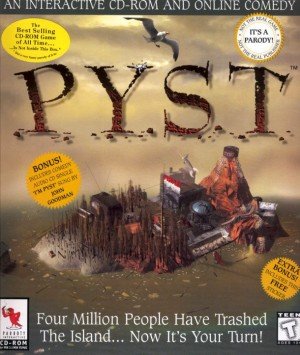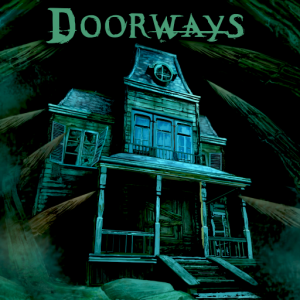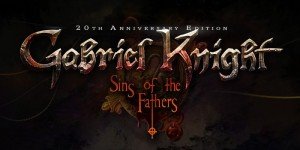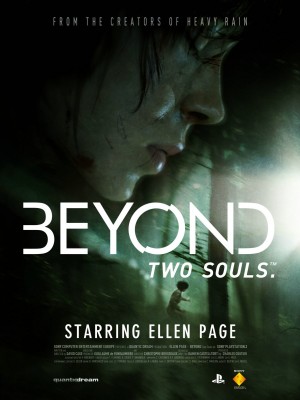Bill Tiller - Duke Grabowski, Mighty Swashbuckler! interview

Some of the greatest videogame art of all time has come from the hand of Bill Tiller. With classics like The Dig and The Curse of Monkey Island to his credit (not to mention his pièce de résistance, the Adventure Gamers logo), Bill has long since established himself as arguably the most talented artist in the medium today. But Tiller is far more than just an artist, having designed A Vampyre Story and Ghost Pirates of Vooju Island in his post-LucasArts days.
In keeping with the piratey theme of his previous work, now Bill is back with a new game, Duke Grabowski, Mighty Swashbuckler!, which promises everything we've come to expect in a Bill Tiller adventure: whimsical humour, colourful characters, traditional point-and-click gameplay, and of course jaw-dropping environments. If the game is to be completed, however, it will first need to reach its crowdfunding goal of $40,000 through Kickstarter. The campaign is well on its way, but heading into the home stretch it's going to need more support from adventure fans in order to succeed. It's a crucial stage for the project, so there's no better time for a heart-to-heart with Tiller himself about what backers can look forward to.
Jack Allin: So, Bill. Pirates.
Bill Tiller: Whenever I do art for a pirate game, I feel like I'm on a mini tropical vacation. I feel relaxed, well-rested and in a better mood.
First, there are the islands. Each one covered in beautiful foliage, sweet-smelling flowers and thick jungles. Who knows what dangers are hidden there? Many islands are active volcanos, which adds an element of danger.
Then there's the sea itself: warm, bright blue and clear, hiding lost cities, shipwrecks, and containing vibrant coral reefs, which are home to a menagerie of exotic sea life.
I also like the visual elegance of the pirate genre. Look at the decorations that adorn the aft castle of the galleons, the figureheads at the fore, the embroidered coats, hats and dresses that pirates wore. Even their pistols and sabers are finely decorated. Everything is shiny brass, copper or gold. Much of the architecture has gilded molding, brightly painted plaster and intricately carved wood.
 |
It may not look like it, but Bill Tiller is on a "mini tropical vacation" |
Monsters of all sorts accompany the pirate genre, including leviathans, ghosts, mermaids, zombies and skeletons. Throw in the Mesoamerican monster myths and the wide variety of dangerous tropical animals (jaguars, snakes, spiders, apes, feral chickens) and that adds another layer of danger.
The pirate genre is set in the Age of Exploration, where peoples and cultures collide. The geography is populated with a wide variety of ethnicities and cultures, including Carib tribes, Mesoamericans, West Africans, Spanish, English, Portuguese and Dutch.
Being able to have a lot of independent, strong women is nice, too. Women had more power and respect among pirates than in civilized society. As long as you held your own in a fight, other pirates respected you, regardless of gender.
And the cherry at the top of the pirate setting is, of course, the treasure, the filthy lucre, the booty – whatever you want to call it. There is just something about seeing mounds of gold, gems and jewels that excites a person. It's beautiful and it can make you rich and powerful. It's always hidden away, challenging to find, usually requiring you to decipher an enigmatic map or code, and always guarded by something dangerous and mysterious, such as nefarious traps, evil curses or the undead.
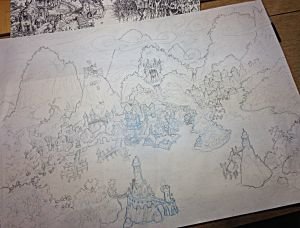 |
The Azurbbean world map begins to take shape (click image for larger version)
|
I think pirates are very appealing on a psychological level because a pirate is basically a rebel who has escaped tyrannical oppression. They are lowly sailors who risk their lives out at sea, and in many cases were pressed into service against their will. They were ruled over by the rich, well-educated upper class who despised them. Themes about the struggle of the hard-working poor against an oppressive elite are universally appealing. There's a reason why Errol Flynn played both Robin Hood and many pirate captains – they are essentially the same thing: heroes who rob from the rich and give to the poor.
(In the pirate's case, the poor is themselves.)
Pirates instituted democracy well before the United States or Europe, installing rules to preserve each individual pirate's liberty. Sounds a lot like the Bill of Rights.
Plus, pirates could sail where they pleased, explore where they wanted, and had no one in authority telling them where to go, what time to be there, or what they had to do. Who, sitting in their boring office, lit by fluorescent lights, working for a jerk at a job they hate, wouldn't want to be out in the Caribbean, stealing from the rich and doing whatever the hell they want? It sounds great! I'd sign up with Blackbeard today, if it weren't for the killing and being killed part, 'cause that would suck.
I have been told by more than a few publishers that pirate games sell really well, which would explain why there are so many. Seems like there are about eight or so genres that have staying power: Gothic horror, medieval fantasy, crime drama/detectives, space operas, westerns, superheroes, and pirates. Hell, even Disney is dedicating a whole land at the new Shanghai Disneyland to pirates.
Tiller's vision of Duke's Gnarly Narwhal tavern almost fully realized
So to sum up "Why Pirates?"
They live in paradise, sail warm beautiful waters, deal in magic, explore mysterious new lands, find hordes of treasure, are surrounded by beautiful handmade objects and architecture, wear fancy clothes, fight dangerous monsters, are massively multicultural, fight tyranny, have total freedom and participate in democracy. Plus, they get to say "arrrgh" and "aye," and talk with a funny accent.
So I just don't say "pirates." I says "PIRATES!"
Jack: Hey, you had me at “ahoy”. But is there any fear of oversaturating the market with pirate adventures, particularly those with an obvious Monkey Island flavour? Might people be getting sick of them? And what would you say to people who find more of such games to be derivative?
Bill: We love Monkey Island. Ron, Tim and Dave did exactly what Mel Brooks did with the Gothic horror and Wild West genres when he made Young Frankenstein and Blazing Saddles, which was to pay homage to them and make fun of them at the same time. I think a lot of pirate games want to follow in Monkey's footsteps, which is fine. We want to acknowledge the greatness of Monkey Island and at the same time poke fun at it. It's kind of a spoof of a spoof, and pays homage to a game that paid homage to Disney's pirate ride.
Jack: Obviously Duke Grabowski isn’t your normal swashbuckler. Or rather, maybe he is but doesn’t want to be. Tell us about Duke.
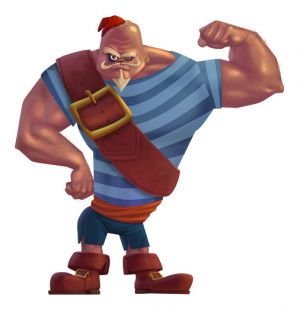 Bill: Duke and his family were indentured servants to an abusive, rich landowner who ran a sugar cane plantation. When Captain Amerigo raided the island, he saw potential in the huge farm boy and took him under his wing. Duke is super strong, but a bit clumsy and kind of slow in the head. He also struggles with being too sensitive and has an explosive temper, making him kind of volatile. Captain Amerigo figured out how to treat Duke so that he felt respected, valued and essential to the crew.
Bill: Duke and his family were indentured servants to an abusive, rich landowner who ran a sugar cane plantation. When Captain Amerigo raided the island, he saw potential in the huge farm boy and took him under his wing. Duke is super strong, but a bit clumsy and kind of slow in the head. He also struggles with being too sensitive and has an explosive temper, making him kind of volatile. Captain Amerigo figured out how to treat Duke so that he felt respected, valued and essential to the crew.
In our world, the Azurbbean is in the midst of a war of rebellion, where island colonies are breaking away from various Continental empires that conquered and enslaved them. The pirates of the Azurbbean are more like Robin Hood, fighting tyrannical rich rulers and freeing slaves and enriching them. Duke fully bought into this goal and vigorously supported and defended Captain Amerigo in his attacks on Imperial shipping.
Other members of Duke's crew are not quite so idealistic, though, and would rather plunder any target, not just the Empire. Their collective fear of Duke and Captain Amerigo keep them in line. If Captain Amerigo and his guard dog were gone, they could be a lot wealthier...
Jack: Could we consider Duke a kind of anti-Guybrush? Guybrush was a meek, mild-mannered lad who desperately wanted to be taken seriously as a pirate, whereas Duke seems like a gruff, rough-and-tumble buccaneer who wants to be taken seriously as a gentleman. Would you say that’s a fair assessment?
Bill: Yeah, though they are both good guys and heroic, so they aren’t exactly opposites. They have the same overall goals, but their personalities are very different. Duke is socially awkward, kind of quiet, and quick to take offense. The big guy also has pretty low self-esteem, which causes him to try hard to get approval from his peers. What Duke needs to learn is that his peers – the ship’s crew – are a bunch of low-life scum and he doesn’t really need them as friends. They don’t like him anyway. They think he is too dangerous and dumb to be part of the crew: stupid, strong and angry is a bad combination in cramped quarters. Duke is easily swayed by charismatic people, and during the game Duke will learn that smooth talkers can be liars, and despite what they say, they don’t really have his interests at heart.
Jack: What are some of the fine messes he’ll be getting himself into in his travels?
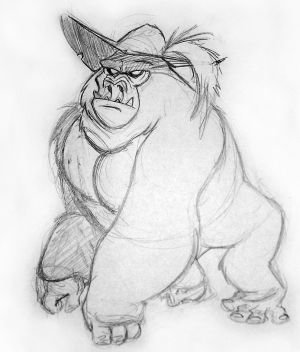 |
A formidable wrestling opponent for Duke (concept by Jean-Louis Sirois) |
Bill: To trick him off the ship, smooth-talking Slewface convinces Duke that not any pirate can be a captain. Only swashbucklers can be captains, and swashbucklers have many talents and one of them is being smooth with the ladies. If Duke can get three women on the island to fall in love with him, that would prove he is a swashbuckler. Once he is a swashbuckler, the crew will vote him as the new captain. So Duke, being easily swayed, thinks this makes sense and goes off to prove he is swashbuckler material. Slewface and the crew know that there is no way this monosyllabic knuckle-dragger is going to get anyone to fall in love with him. They think they are scot-free. Duke is nervous and has no idea what to say to the fairer sex and just makes a mess of things.
Some other messes involve a wrestling match with a 500-pound gorilla, a fort full of wicked Vooju Raiders, and an unexpected lesson about the power of Vooju.
Jack: What can you tell us about some of the other colourful characters he’ll meet along the way?
Bill: First, he gets to know Sheriff Nancy Steele real well, because she realizes Duke is trouble and is constantly watching and arresting him.
 |
Sheriff Nancy Steele |
Now, Duke's mom taught him to be respectful to the police and women, so Duke generally does what Nancy says. At first, Nancy thinks he is a dumb oaf who is going to ruin her town, but then as she gets to know him better, she begins to sympathize with him more, and even to like him a little. She slowly pieces together the whole story and figures out that his crew has sent him on a wild goose chase. At first this just annoys her that they sent him to her island, but after a while she starts to kind of root for the big guy.
Duke will also meet Jane Starling, one of the main characters from Ghost Pirates of Vooju Island. She is on a secret mission again, and has finally met her match, an as-yet-to-be-named 500-pound gorilla. Jane thinks Duke might just be the perfect man to help her out.
He will also meet and help Lady Aziza, a North African lady who is trying to escape with her two girls from her wealthy and powerful husband. The kids were captured and are being held for ransom by a gang of Vooju-worshiping pirates called the Ogu Raiders. Can Duke help save them?
Duke will also meet the pirate ladies of the Gnarly Narwhal tavern, and the beefcake that parade around as the island’s firemen.
Jack: That’s quite the lineup. Can we count on more traditional adventuring that we’ve come to expect from you over the years? Any (gameplay) surprises up your sleeve?
Bill: Lots of traditional gameplay, for sure, but to simulate what it’s like to be Duke, we have added a few wrinkles that will vary up the gameplay quite a bit. I like to add new wrinkles when I can, like Mona’s vampire powers, or the ghost powers from Ghost Pirates of Vooju Island. In this case, I want Duke’s strength, anger issues, and slow wits to be represented in the gameplay and puzzles. They can be a boon at times, and a real burden at others.
Duke's prodigious strength will factor into the gameplay, but an insult swordfighter he is not
Jack: You’re once again working with Gene Mocsy, your partner-in-crime on Ghost Pirates. What makes you and Gene such a good team?
Bill: Gene is patient and pretty indefatigable. He is also very well-read and knowledgeable. Plus, he is an actor, writer, artist and filmmaker. So we have a lot in common. But most importantly, he has a great sense of humor. I love stand-up comedians, especially the more controversial ones like Dave Chappelle, Lisa Lampanelli and Greg Giraldo, and they have influenced my humor. But that also means I'm inappropriate at times, and Gene is good at keeping me on the straight and narrow.
He also has a great imagination and comes up with a variety of ideas, very quickly. I tend to focus on plot and characters, and Gene can take the skeleton I come up with and completely flesh it out, taking what was fairly thin in concept and making it real. That is basically the way we complement each other.
Gene also has a pretty level head, whereas I am all over the place, from super high to apathetic low. He is this solid steady force that keeps the train rolling down the track.
 |
Duke team Bill Tiller, Jeremiah Grant, Gene Mocsy |
Jack: How did the two of you meet and end up working together originally?
Bill: He and my wife, and Jeremy Koerner (the voice of Froderick the Bat) were all part of a theatre company. Gene found out that I was looking for a scripter and writer for A Vampyre Story and another unnamed game. We hit it off right away, and have been helping each other's projects ever since.
Jack: So who’s responsible for what in particular on Duke Grabowski?
Bill: Jeremiah Grant, Gene Mocsy and I share responsibility. We all have our areas of focus, but have input on the whole company and project. I concentrate on story and art, as well as contribute to puzzle design. Gene focuses on writing and puzzle design and contributes to art and scripting, as well as organizing the voiceover work. Jeremiah focuses on technology and business development, and also does the rigging and scripting. If our Kickstarter succeeds, we will hire Romero Alves to lead the animation, and we'll contract out our character modeling, though we hope Ed Brilliant will do most of the important character work. We hope to have all new music for the game and that is one of our first reach goals with the Kickstarter.
Jack: You’ve said Duke Grabowski wasn’t originally intended to be a full-fledged game, but rather a short, experimental test for a new engine. What made you change your mind about giving Duke his own game?
Bill: Yep, a proof-of-technology demonstration. One of the hardest and most expensive issues we had with A Vampyre Story and Ghost Pirates was engine development. It was costly, slow, and very expensive, not to mention frustrating. Jeremiah dealt with that issue first-hand, and wanted to come up with a better solution. He started using Unity and Adventure Creator and realized it would work well for our needs.
So, Jeremiah needed art assets and a short game design, and asked me to help with that. We didn’t have a budget and didn't want to raise money just for a demo, so we decided to reuse as many assets as we could from AVS and Ghost Pirates. I sketched up an idea for an Old English-style inn with a pirate ship on top of it. Like I had said before in one of our Kickstarter updates, I'd seen a nightclub in San Francisco that had a cargo plane installed in the center, so I thought this would be the pirate equivalent. I thought it was a strong image and that we could base a puzzle on trying to get in. None of the main characters from Ghost Pirates made sense for the puzzle, so I talked Jeremiah into going with a new main character.
My family and I had just seen Blazing Saddles and loved it, especially the scenes with Mongo. I remember thinking, I wish Mongo had his own movie, and that's when it hit me: Let's make Mongo a pirate, and give him his own game.
Kickstarter campaign video
Now, I like variety in character designs, and in Ghost Pirates we had good variety of ethnicities, genders and body types. We didn’t have a really pale character, so I decided we would make this guy really blonde and pale, but in the sun he turns lobster-red. His body type has no business being in the tropics at all. Duke will never die in a fight, he's too tough, but he will probably be taken down by skin cancer.
Clearly a big guy like that needed to have a one-syllable, solid first name, and I liked "Knute", but then his last name was going to be Polish, "Grabowski", after the nickname for Chicago Bears fans, so that wouldn’t work. Then I thought "Duke" might fit, because it's John Wayne's nickname, who is a pretty tough and big guy. Big Duke Grabowski.
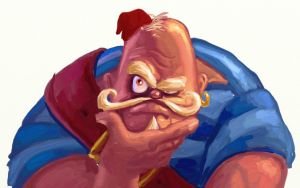 |
The ideas just kept coming for Duke until he needed his own full-fledged adventure |
Then I thought, why does he need to get in this bar? To meet women? I didn’t want to make a pirate Leisure Suit Larry, so I figured he might have been goaded into getting in the bar, probably as a joke or a wild goose chase. And the story just kind grew from there. I thought it might be funny to see this big dimwit try to woo women and act smooth. Ultimately it doesn't work out, but he is so nice and good-hearted that he gets women to like him for who he is and what he does, rather than being a smooth operator or a pick-up artist.
This plot was too big for just a demo and I kept expanding it, which my brain often does. I just loved this character and the scenario too much. At the time, Gene and I were actually working on the design and story for a completely different game. But we had put so much work into this proof-of-tech demo that it became obvious that Duke and his story needed its own, albeit short, game.
Jack: So Duke will be a fairly “small” game in terms of scope?
Bill: Yes, an estimated 12 locations, one-fourth the size of A Vampyre Story. We decided to fund the game on Kickstarter and we didn’t want to have to raise a lot of money. We figured if we kept it short, we could do it while keeping our full-time jobs and make the game in our free time over the next 12 months. This way we wouldn’t need to hire a whole crew and we could do the work for free. We would just raise enough money, $40,000, to pay for what we couldn’t get for free or do ourselves, like buy software, pay for new models, and pay an animator.
 |
Could the villainous Slewface be the key to more Duke adventures? |
Jack: Is Duke Grabowski intended as a one-off adventure, or could it be the beginning of a whole new series?
Bill: It is just a one-off. But I could see how Slewface, the villain in the game, could find other ways to trick Duke into leaving the ship. Spoiler alert: Duke doesn’t die in the end, so who knows?
Jack: You’ve already got one series in progress, which hasn’t really seen a lot of progress in recent years. What can you tell us about the status of A Vampyre Story?
Bill: Not much, really. I am legally obligated not to talk about A Vampyre Story 2. All I can say about A Vampyre Story: Year One is that it is on hold for legal reasons. Crimson Cow owns the development rights to A Vampyre Story 2, and any questions about that game should be directed toward them. So having that restriction meant I had time to work on other games in the meantime, and Duke is all that I am focusing on now. And I like the fact that it will be a short game. It means it won’t take years to do.
Jack: You’ve also had your hand in a few other adventure proposals lately, including the sequel to Kaptain Brawe. How are you able to juggle multiple projects at once?
Bill: I generally split my day in two sections. The first half of the day is on paid work for other companies, usually 6-8 hours. And the second half of my day is dedicated to my own projects, about 2-4 hours. Cateia Games (Kaptain Brawe) is a paying job, so that game is going to be what I work on during the first half of the day, and then Duke will be my unpaid, second-half project. Since Duke is a short game, it's going to be very manageable.
Bill discusses his art process as he draws Duke Grabowski's Inn
Jack: As a game designer, you’ve gone the indie route in recent years. Why continue to go it alone? Surely someone with your abilities would have no trouble landing a job with a larger, more established developer if you so choose.
Bill: I have. I was one of the first art directors on Guild Wars, then I was third-party art director at Midway on Happy Feet, The Suffering and a Spy Hunter game. I worked as an art director on EA’s The Two Towers game, and worked with Owlchemy labs on Smuggle/ Snuggle Truck, and Jack Lumber. And at Munky Fun, I did My Horse and Bounty Bots.
Some of the best friends I have, I met while working at companies, and many of the projects I have done were a lot fun. But sometimes there can be too much drama, too many cooks in the kitchen. It seems like I can work at a company for few years, and then I need to do freelance for a few years. Currently, I have enough projects and freelance work that I don’t need to work at a bigger company. Who knows, maybe Venture Moon Industries will transition into a big company, anyway.
Jack: Do you keep in touch with your old LucasArts colleagues? Any chance of collaborating with any of them again in future?
Bill: Yes and yes. I am working with Dave Grossman right now, in fact. We are swapping skills; I'm helping him with some concept art and he will help Gene and me with the Duke game design. Alyssa Clark, a former LucasArts employee, is now a successful TV writer on Teen Wolf on MTV. She will be writing some dialog for Duke, as well. And I'm trying to get other LucasArts vets to help. Larry Ahern will, just for fun, make a cameo in the game, along with Dave Grossman.
Jack: Kickstarter, of course, is the phenomenon that makes indie development more viable. Tell us about the experience of working on a Kickstarter campaign.
 |
A sketch of Duke Grabowski's sea monster graveyard
|
Bill: It’s exciting, heartbreaking and perplexing, all at the same time. I feel you need to be a bit of a psychologist when strategizing your Kickstarter, and I am by no means an expert at it, at all. But I have learned a thing or two. First, it helps if you have a successful track record before you start. That way, people know what to expect. Next, it helps to have your project already planned out, so when you get hit with a wave of questions about the project, you have the answers at the ready. Make sure all your bases are covered, because you can't do everything yourself and you aren't great at everything. Have a team that is ready and willing to do the things you can’t. Some of your fans will get your vision, but there are critics out there who need to be reassured you know what you are doing, and they won’t hold back.
Jack: Unfortunately, you haven’t had great success with your crowdfunding projects so far. In fact, interest in Kickstarter adventures in general seems to have waned in recent times. Do you still see it as a viable funding model?
Bill: Yes and no. It’s a good way to get noticed and get a reasonable project started, but it by no means replaces publishers, nor investors. It's to kickstart your endeavors, not sustain them, thus the name.
It’s a shame that the interest in KS adventures is waning, because it's one sure way adventure fans can get new games in a genre that publishers are not rushing to support. I would encourage adventure game buyers to keep funding them so that there are plenty to choose from, and it will encourage developers to take risks with new ideas. If fans show their enthusiasm for adventure games, publishers aren't dumb – they will take notice. The future of adventure games is in our hands.
Jack: Why do you think some Kickstarters have succeeded while yours did not?
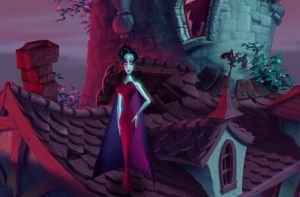 |
A Vampyre Story: Year One |
Bill: I have only done one, A Vampyre Story: Year One, and I can answer that pretty simply. It failed because it was my first one. My team, our lead animator Romero Alves especially, worked very hard on making a four minute, fully-animated video. We thought that would be enough to convince people that the game was going to be high-quality.
But as I now know, you have to do live-action video with yourself in it, and you need to follow it up with a lot of updates, and you need to be very good at PR. Plus, we had plenty of fans of A Vampyre Story, but they understandably wanted a sequel more than a short prequel. “I don’t have the rights anymore to make a sequel, but I was able to negotiate the right to make a prequel, so I hope a short prequel will be better than nothing,” is what I thought.
To many people, it was. We did raise $70,000.
Currently A Vampyre Story: Year One is on hold for reasons I can't discuss. But I want to make it someday, because I think it's a good game that people will like.
What we did differently this time was ask for only the bare minimum of money we need to make it. Instead of $200K, which would cover all the costs for everything, including a lot of very cool rewards, we asked for $40K and decided to give rewards that were for the most part made by us.
We will keep the cost down by doing most of the game development for free. We're just raising money for the things we can’t do for free, like the animation, the new character models and some of the physical rewards. We also bartered with people to work on the game by trading skills with them.
And we got the basic technology worked out in advance, so we can reassure people that the game already works.
Saying no to Duke could be hazardous to your health
Jack: What have you done differently for Duke Grabowski to turn the tide in your favour?
Bill: I think it is going very well, pretty much how I expected. I think the only thing that I wish I had clarified sooner was the misconception that the plot is sexist. The villains in the game, Duke's crewmates, are a gang of sexist boors, for sure, but our hero is not. He is actually a nice guy who is easily duped. The game is really about how we sometimes do dumb things to impress our peers. And how sometimes they aren't worth impressing. The message I want to express in Duke Grabowski, Mighty Swashbuckler! is this: have respect for yourself and be true to your nature, don’t let others influence you into doing what you think is wrong, and be careful when you pick your friends. Keep the good ones, the reliable and loyal ones, and discard the ones who bring you down or don’t really respect you.
Jack: Well, we certainly wish you success. The genre needs a new Bill Tiller adventure! Any final words for those still undecided about hopping aboard the Duke Grabowski bandwagon?
Bill: Thanks! That is nice of you to say. I think they should support the game because it’s going to be a lot of fun to play. When you sit at the computer and start the game up, you are going to be transported to a beautiful tropical world, filled with danger, exciting action, funny situations, and great characters. You’ll get to play an unusual protagonist who has interesting issues to overcome, someone who is powerful and brave, yet very sensitive, emotional and insecure at the same time. It has many great elements that I am convinced people will really enjoy. Plus, we got a great group of experienced and talented people working together to make sure that the game is polished and is as close to perfection as possible. The game will be short and sweet and there really is nothing I can see that is risky about backing this game. The reward should be pretty darn fun.











